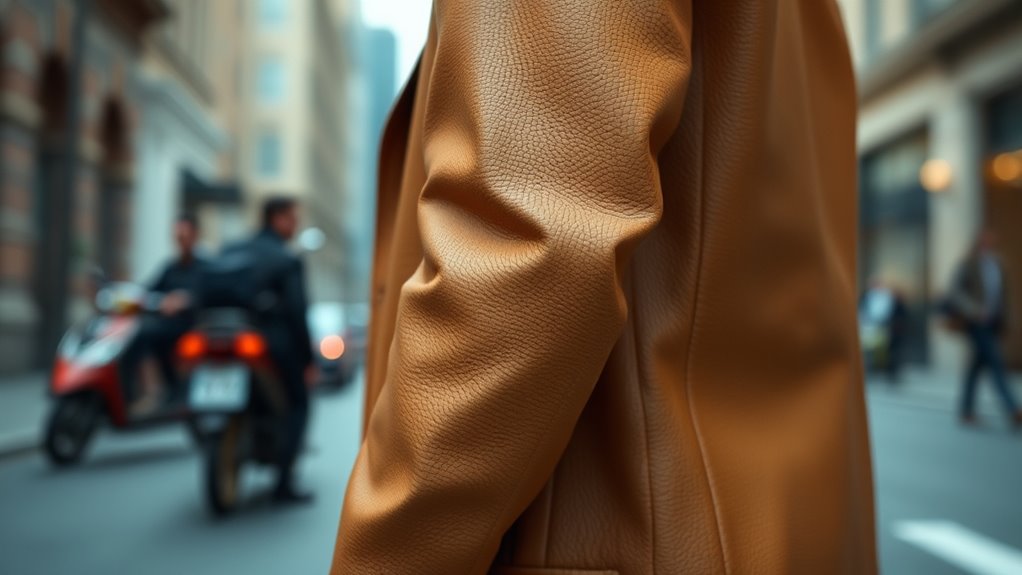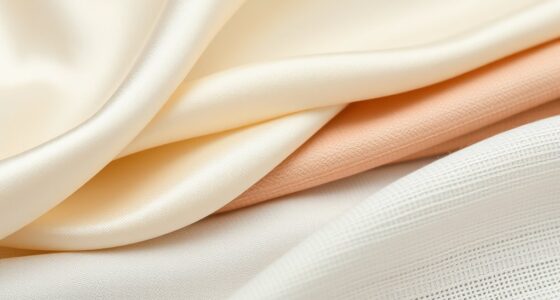Incorporating plant-based leather into your daily outfits lets you craft stylish, versatile looks while staying eco-friendly. You can choose items like jackets, shoes, or accessories made from sustainable materials such as pineapple, mushroom, or apple peel leather. These pieces are lightweight, flexible, and age beautifully over time, adding character. Plus, they support ethical production and reduce your carbon footprint. Keep exploring to discover even more ways to enhance your wardrobe sustainably.
Key Takeaways
- Choose versatile plant-based leather accessories like bags and belts to seamlessly complement casual and formal outfits.
- Incorporate plant-based leather footwear, such as sneakers or loafers, for stylish yet sustainable everyday wear.
- Use plant-based leather jackets or blazers as statement pieces that add eco-friendly sophistication to your wardrobe.
- Pair plant-based leather accents with natural fabrics like cotton or linen for a balanced, eco-conscious look.
- Opt for minimalist or bold designs to match various personal styles while supporting sustainable fashion choices.

As sustainable fashion gains momentum, plant-based leather has become a popular choice for stylish outfits. You’re likely exploring ways to incorporate this eco-friendly material into your wardrobe, and it’s easy to see why. Plant-based leather offers a compelling alternative to traditional leather, especially when it comes to sustainable sourcing. Unlike conventional leather, which often involves resource-intensive processes and ethical concerns, plant-based options are derived from renewable materials like pineapples, mushrooms, or apple peels. This means you can enjoy the look and feel of leather without contributing to environmental degradation or supporting exploitative practices. When you choose plant-based leather, you’re supporting a more sustainable supply chain, which aligns with your values and helps reduce your carbon footprint.
Plant-based leather offers an eco-friendly alternative, supporting sustainable sourcing and reducing environmental impact.
One of the key advantages of using plant-based leather in your outfits is its impressive style versatility. It easily adapts to various fashion statements, from casual to sophisticated, making it a practical addition to your daily wardrobe. You can incorporate plant-based leather into a sleek jacket that elevates your everyday look or opt for a chic pair of shoes to add a touch of elegance to jeans and a t-shirt. Because it’s lightweight and flexible, plant-based leather can be molded into a variety of accessories and garments, allowing you to experiment with different styles without sacrificing comfort. Whether you prefer minimalist designs or bold, statement pieces, plant-based leather offers a range of options that can seamlessly blend into your existing wardrobe.
Furthermore, plant-based leather ages beautifully, developing a unique patina over time that adds character to your pieces. This durability makes it a smart investment for your wardrobe, as you can wear your favorite items for years to come. Plus, many brands now prioritize using sustainable sourcing practices, ensuring that the materials they use are ethically harvested and processed. When you buy plant-based leather products, you’re supporting companies that value transparency and environmental responsibility, which is important if you want your fashion choices to reflect your commitment to sustainability.
In addition, the growing popularity of plant-based leather is inspiring innovations that involve WWE Raw’s financial impact, leading to increased investment in sustainable materials and practices across industries. Incorporating plant-based leather into your outfits isn’t complicated; it’s about making thoughtful choices that align with your style and values. With its sustainability credentials and style versatility, plant-based leather empowers you to look good while doing good for the planet. Whether you’re updating your wardrobe or seeking accessories that stand out, this innovative material offers a way to stay fashionable and environmentally conscious at the same time.
Frequently Asked Questions
How Durable Is Plant-Based Leather Compared to Traditional Leather?
Plant-based leather tends to be slightly less durable than traditional leather, but its wear resistance has improved considerably. You’ll find that it holds up well with regular use, especially if you choose high-quality options. While it may show signs of wear sooner, its eco-friendly benefits make it a worthwhile choice. Just keep in mind that durability comparison varies by brand and material, so always check product reviews before making a purchase.
What Maintenance Does Plant-Based Leather Require?
Think of plant-based leather as a delicate garden needing gentle care. You should clean it with soft, damp cloths and avoid harsh chemicals. Use specific cleaning tips like mild soap when necessary, and always store your items in cool, dry places—preferably in breathable storage solutions. This way, your plant-based leather stays vibrant and lasts longer, making it a sustainable yet stylish choice for everyday outfits.
Is Plant-Based Leather Suitable for All Climates?
Plant-based leather offers good climate adaptability, but it’s not perfect for all weather. You’ll find it provides seasonal versatility, keeping you comfortable in moderate temperatures. However, in extreme heat or heavy rain, it may not perform as well as traditional leather or synthetic options. To maximize its lifespan, consider protecting your plant-based leather items from excessive moisture and direct sunlight, especially in unpredictable climates.
Can Plant-Based Leather Be Recycled or Composted?
Yes, plant-based leather can often be recycled, but recycling challenges exist due to mixed materials, making it less straightforward than other recyclables. While it offers biodegradability benefits, some types may not compost easily, especially if treated with chemicals. You should check product labels and disposal guidelines to guarantee proper recycling or composting, helping reduce waste and maximize the environmental benefits of plant-based leather.
How Does Plant-Based Leather Impact Environmental Sustainability?
Think of plant-based leather as a gust of fresh air for sustainability. It often offers better biodegradability than traditional leather, helping reduce landfill waste. By choosing products with ethical sourcing, you support environmentally friendly practices and fair labor. This shift lessens the ecological footprint, making your fashion choices more eco-conscious. Overall, plant-based leather positively impacts environmental sustainability by being more sustainable and ethically produced, helping you make a difference with every outfit.
Conclusion
Incorporating plant-based leather into your outfits not only boosts your style but also helps protect the planet. As the saying goes, “Every little bit counts,” so even small choices can make a big impact. By choosing sustainable materials, you’re making a statement that fashion and environmental responsibility can go hand in hand. So go ahead, embrace plant-based leather—your wardrobe and the Earth will thank you for it.









